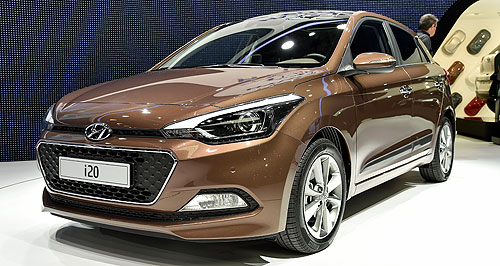Make / Model Search
News - HyundaiParis show: Hyundai upgrades drivetrain techQuick sticks: It would make sense for Hyundai to debut its new seven-speed dual-clutch automatic transmission in a sporty model such as the Veloster Turbo coupe. Seven-speed dual-clutch transmission only Hyundai tech likely to show up in Oz soon3 Oct 2014 HYUNDAI has used this week’s Paris motor show to showcase a raft of drivetrain technologies, including new three- and four-cylinder turbo-petrol engines, a seven-speed dual-clutch automatic transmission and a mild hybrid system. Being a market with a preference for automatic transmissions, the seven-speed dual-clutch transmission is the most likely of these technologies to arrive on these shores first. GoAuto understands the dual-clutch cog-swapper might surface in a future iteration of the Veloster Turbo coupe, replacing the six-speed torque converter unit. As reported, Hyundai sister brand Kia has confirmed it will roll out the seven-speed transmission across many models, with the Rio light car and Pro_cee’d GT hot hatch – that shares its 1.6-litre turbo-petrol engine with the Veloster Turbo – first in the queue. However, Australian customers should not hold their breath for the new small turbo engines as they are currently Europe-only. And due to a slow uptake of hybrid systems here, combined with a lack of current right-hand drive engineering for them, they are not expected to appear in local showrooms anytime soon either. The new 1.0-litre, three-cylinder Kappa T-GDI (turbo-petrol with direct injection) engine will be capable of producing peak power of up to 88kW and 172Nm of torque, and has been confirmed to debut next year in the next-generation i20 light hatch – a model that remains unconfirmed for Australia due to production of developed-market variants relocating from India to Turkey. As is becoming the norm, the turbo triple has separate cooling circuits for the engine block and cylinder head, with the latter having a fully integrated exhaust manifold, to ensure optimal thermal management for quick warm-up and the related emissions and efficiency benefits. An electronically controlled turbo waste-gate and 200-bar, six-hole fuel injectors help the three-pot burn cleanly enough to satisfy the most stringent Euro 6c emissions standards three years before they become mandatory on the Continent in 2017. Moving up a cylinder and in size, the 1.4-litre T-GDI engine was showcased in compressed natural gas (CNG) guise, with the lower calorific value of this fuel resulting in reduced outputs off 86kW and 206Nm but making up for it with a low CO2 emissions rating of 87 grams per kilometre. The four-cylinder unit is smaller and 14kg lighter than the non-turbo, 1.4-litre Gamma unit it will replace, while being more powerful and efficient due to direct injection and a high-pressure single-scroll turbo built into the exhaust manifold – a location Hyundai says improves throttle response and low-end torque delivery. Hyundai demonstrated the 1.4-litre Kappa engine in the i30 CNG concept that was also fitted with the brand’s new seven-speed dual-clutch transmission that is claimed to provide fuel efficiency and acceleration gains. The new transmission uses two dry clutches and an electric actuator to improve responsiveness, while reducing noise, vibration and harshness with an external damper. At the Geneva motor show in March, Hyundai sister brand Kia previewed the new dual-clutch transmission as well as the 48-volt mild hybrid system – that also appeared under the bonnet of an Optima sedan at Paris – while the Kappa 1.0 T-GDI three-cylinder turbo-petrol unit was shown on Kia’s 2013 Geneva show stand. Like Kia’s prototype, the Hyundai 48V hybrid uses a lead-carbon battery – chosen for its power/cost ratio, rapid charging ability, durability, low-temperature running and high level of recyclability – to boost engine output by 10kW via a belt-driven starter generator claimed to re-start the engine without noise or vibration. Hyundai claims a 15 per cent performance boost and 20 per cent reduction in CO2 emissions from the system, which costs just 25 per cent as much as a full hybrid system while adding just 46kg of weight to the vehicle and not compromising interior or luggage capacity (the battery is stored in the spare wheel cavity). The electric boost helps eliminate turbo lag, meaning the 1.7-litre turbo-diesel engine can be fitted with a bigger blower for a performance increase to 114kW of power and 360Nm of torque.  Read more3rd of October 2014  Dual-clutch set to lift Kia Pro_cee’d GTKia’s seven-speed dual-clutch transmission set for belated birth in Pro_cee’d GT25th of September 2014  Hyundai delivers H350 cargo vanNew Hyundai H350 cargo van revealed but still not confirmed for Australia17th of September 2014  Hyundai Santa Fe gets midlife updateStyling tweaks for Hyundai Santa Fe, plus more kit for top variants in fresh range4th of September 2014  Paris show: Hyundai reveals full Euro i20 details‘Class-leading interior’, new engines and tech for Hyundai i20 |
Click to shareHyundai articlesResearch Hyundai Motor industry news |











Facebook Twitter Instagram